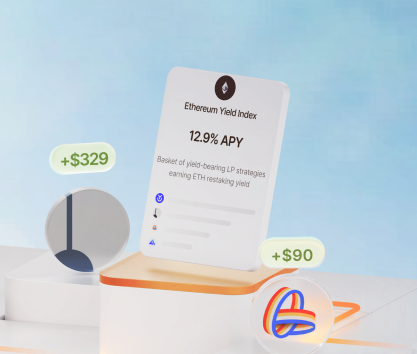It can be difficult to build a strong portfolio capable of delivering excellent results in the long run. The crypto market does not offer an awful lot of investment opportunities that can be used as the backbone for a balanced asset composition. However, many novel financial products available to all users of the DeFi ecosystem can be used to achieve outstanding returns.
By taking advantage of generous DeFi reward mechanisms allowing investors to optimize profitability and make more money than in any other traditional market, a smart capital holder can quickly increase the size of their portfolio.
We are going to talk about some of the most lucrative financial instruments in the DeFi ecosystem, where you can get some useful digital assets. Yield tokens, which DeFi enthusiasts so like talking about, can be a nice addition to any portfolio focused on digital investments. Note that we do not give financial advice and encourage all our readers to do their own research before committing to any of the investment strategies that we discuss below.
How yield farming works
The Decentralized Finance ecosystem is slowly gaining mainstream traction. Nonetheless, it is still a relatively small financial system. For instance, the combined total value locked of the whole sector has dropped dramatically since December. It is now at a timid level of just $40 billion. While some investors may think that it is a huge number, there are hundreds of investment funds that dwarf this number.
To increase the number of active users and achieve higher adoption metrics, decentralized protocols need to provide an excellent service that rivals what traditional institutions can offer. Many protocols already have great UX/UI and competitive terms and conditions. Unfortunately, some technological inefficiencies, relatively high risks, and difficult onboarding hold the ecosystem back.
At the same time, decentralized exchanges and lending platforms need funds to operate properly. To attract capital to their pools, these protocols offer competitive APYs and some cherries on top, usually, in the form of reward tokens. Investors allocate capital to pools, receive their rewards, and can exit the market at an opportune moment to cash out. Alternatively, you can use these tokens for their utility, discounts, or governance voting.
Yearn.finance and Aave examples
The DeFi ecosystem features a myriad of interesting protocols offering all sorts of incentives to their users. However, some stand out from the crowd because of their sheer size (Aave) or inventive approaches to investing (Yearn). We are going to discuss these two platforms in a little bit more detail to provide some additional context.
- Aave is a protocol with a massive TVL of over $15.9 billion. It is the biggest lending platform in the decentralized finance sector. Despite many setbacks, the platform managed to keep performance metrics quite high. The peak TVL number was achieved in December 2024 when Aave had a $23 billion TVL. Currently, the protocol offers 167 pools across 11 chains with an average APY of 1.15%. Aave tokens can be earned through the staking program.
- Yearn.finance is a yield aggregator that uses various forms of automation to increase the profitability of various yield farming setups. It is a great selection for investors seeking inventive ways to allocate capital without the need to research different types of protocols and their pools. Yearn is an Ethereum-based protocol. Here, you can invest in 148 pools with an average APY of 16.69%. The protocol offers multiple rewards, including a solid 8.84% in YEARN tokens for USDS investments.
Note that Aave’s headlining token is not AAVE itself. This one is used for voting in community-driven proposals that determine the future of the protocol. Just like many other governance tokens in DeFi, this one has intrinsic value as long as the issuing platform exists and has an active community.
To enhance the financial activity on the protocol, it uses a proprietary algorithmic stablecoin called GHO. It can be invested in multiple pools to earn additional rewards and a solid APY on top of that.
Other protocols offering rewards
There are multiple categories of decentralized protocols that offer a wide range of different incentives to users.
Here are some of the most prominent types:
- Decentralized exchanges (DEXes) provide a valuable financial service to the DeFi community. Here, users can exchange different types of digital assets without giving up control over their finances. The non-custodial nature of the service attracts many crypto enthusiasts. Liquidity mining, explained in simple terms, is a process of receiving rewards for liquidity provision. You supply pools with certain assets and receive rewards for doing so.
- Lending protocols may or may not offer rewards. It depends on the core design philosophy of the development team and the community behind the DAO. Here, the role of education in understanding complex yield mechanisms is quite important since you have to understand why certain protocols choose to offer higher APYs and rewards in native tokens while others stick to very limited functionality.
- Bridges also offer rewards to users who are willing to provide liquidity for cross-chain swaps and asset relocation. These cross-chain solutions often need massive capital on both sides of the exchange route. They also use centralized entities called Oracles that exist outside of the DeFi ecosystem. Bridges are becoming more popular with the growing interconnectedness of the decentralized finance domain.
Many reward programs are incredibly lucrative and offer APYs that dwarf anything that traditional financial institutions can offer. However, many experts consider all investments in these strategies to be dangerous. The risks of yield tokens are numerous, and many traditional risk management tricks do not work for them.
Here are some of these risks:
- Inflationary nature of many native tokens. Often, tokenomics are set up in a way that significantly increases inflationary pressure in the long run. Unlimited total supply, volatile market conditions, and early investors trying to cash out create unhealthy market circumstances all the time.
- Technological risks. All decentralized protocols operate by using smart contracts. The vast majority of reward tokens are tied to the technological infrastructure of issuing protocols. It means that these digital assets can have vulnerabilities, exploits, and bugs.
- Unclear regulatory frameworks. The EU has its MICA initiative, while the US is still struggling to find a consensus between the SEC, IRS, and other agencies. The consequences of regulatory changes for investors in yield tokens can be massive or negligible. We still do not know how regulations will impact investors.
In 2024, yield farming was a very hot topic among crypto enthusiasts. It is still a very important part of the DeFi ecosystem, but the social sentiment is changing with many users preferring something more consistent and reliable, like lending or liquid staking.
The future of DeFi yields
Various forms of yield farming will remain popular among DeFi users. However, investors should not expect this particular sector to experience in popularity boom. Many protocols must survive the initial battle for attention. Right now, some Solana protocols have outrageously high APYs and incredibly lucrative rewards. However, underlying projects are shady and do not live long enough to allow investors to earn money.
At the same time, the technological breakthroughs may impact the direction in which the sector will move in the near future. We are already seeing how artificial intelligence analyzes income maximization strategies and often includes yield farming options in them.
If you are interested in finding some of the most reliable protocols for yield farming, we strongly recommend checking out the Rivo Yield Marketplace. Here, the catalog contains only trustworthy options selected by professionals and verified by experienced specialists. You can choose from a rich variety of protocols that have different levels of profitability and risk.









